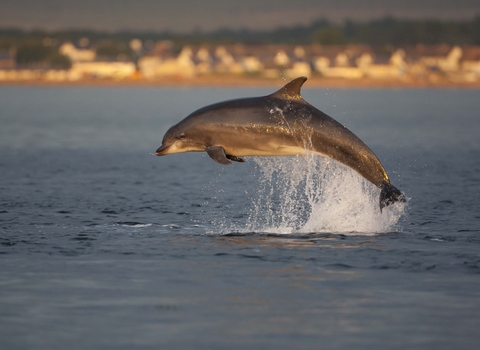
Bottlenose Dolphin ©John MacPherson/2020VISION
Bottlenose dolphin
Bottlenose dolphins in British waters are the biggest of their kind – they need to be able to cope with our chilly waters! They are very sociable and will happily swim alongside boats, providing people on the boat a wonderful wildlife experience.
Scientific name
Tursiops truncatusWhen to see
January to DecemberSpecies information
Category
Statistics
Length: up to 4m Weight: 500kg Average Lifespan: 45-50 yearsProtected in the UK under the Wildlife and Countryside Act, 1981, listed under CITES Appendix II and classified as a Priority Species under the UK Post-2010 Biodiversity Framework. Also protected under the Conservation (Natural Habitats, etc.) Regulations (Northern Ireland) 1995
Habitats
About
Bottlenose dolphins are the most familiar of our dolphins and most likely seen from British shores. These dolphins are the biggest bottlenose dolphins in the world – their size helps them cope with our chilly waters. The best places to see them are the Moray Firth in Scotland, Cardigan Bay in Wales and the coasts of Cornwall, Northumberland and North Wales. They are very social animals and can often be seen in small groups of up to 15 dolphins. They love to jump out of the water and will happily approach boats to bowride (surfing in the waves created by the boat). They feed on fish, often working as a team to hunt.How to identify
A chunky, fairly plain grey dolphin, darker above and paler below. Their beak is short and stubby and their dorsal fin is large, sickle-shaped and often marked with notches and scratches. Bottlenose dolphins are often sighted close to shore alone or in small groups. Look out for boisterous splashing and breaching - and don't be surprised if they approach your boat to check you out!Distribution
Found all around the UK, common in the Moray Firth, Cardigan Bay and off Cornwall.Did you know?
Individual bottlenose dolphins can be recognised from the unique pattern of nicks and notches on their dorsal fin - a bit like a fingerprint! Dolphins can then be tracked over their lifetime using only photos of their fins.How people can help
Report your sightings of bottlenose dolphins to your local Wildlife Trust. If you meet dolphins whilst at sea, maintain a distance of at least 100m, especially if groups contain calves. If the dolphins approach you, maintain a constant speed and allow them to interact on their own terms and leave at will. If you find a stranded bottlenose dolphin (dead or alive), please report it to the relevant authority.
Entanglement in marine litter and ghost fishing gear is a threat to all marine mammals, so why not participate in a beach clean or simply pick up and safely dispose of any rope, strapping or net next time you're at the beach.
